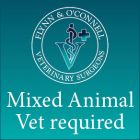Focus - Herd Health - March 2019
The role of the vet and vaccination in BVD eradication
Significant strides have been made in controlling bovine viral diarrhoea (BVD) infection since the national eradication programme was introduced with many questioning whether the need for BVD vaccination still exists. Suzanne Naughton MVB veterinary technical advisor, MSD Animal Health, seeks to answer this question
Since the inception of the national BVD eradication programme in 2013, significant strides have been made in controlling BVD infection in Ireland as well as reducing the retention of persistently infected (PI) calves on farm. The most recent results from the programme highlight this reduction. Out of over 2.3 million calves tested in 2018, 1,323 or 0.06% were confirmed PI calves after the second retest, almost half the number of confirmed PIs found in the previous year. So far in 2019, this trend is continuing with even further reductions in the number of calves confirmed as PI, when compared to the same period in 2018.¹
To vaccinate or not?
As the number of herds with a negative herd status steadily increases, many herd owners and veterinary surgeons are asking the question, is there still a need to vaccinate against BVD?
Considering the programme results so far, although extremely positive, BVD virus is continuing to circulate on certain Irish farms today, resulting in the birth of PI calves. As we identify and remove these PI calves from individual herds, we remove the source of natural infection and, as a result, prevent the development of natural immunity. Consequently, herds become increasingly naive and are so at a heightened risk to re-emergence of the virus and its associated negative effects.
Another interesting question is, how long can BVD virus circulate in the absence of PI animals? A study carried out by Moerman et al. investigated the epidemiological aspects of BVD infections in a large dairy herd over a period of three years. Virus spread was monitored in two groups, one part of the population which contained only transiently viraemic cattle and another part that contained only persistently viraemic calves. Study results showed that in the group with transiently viraemic cattle present, the virus circulated for two and a half years highlighting the length of time a virus can circulate. Interestingly, in the group where PI animals were present, virtually all susceptible animals that encountered the PI became seropositive within three months, emphasising the efficiency of transmission in the presence of one PI animal.²
Another study carried out by Moen et al, investigated the transmission of BVD virus in the absence of a PI animal in a closed dairy herd over a six-year period. At the beginning of the study, blood samples from all animals were examined by virus isolation and no PI animals were identified. During the entire six-year period one calf was a confirmed PI in the fourth year of the study while five congenitally infected non-PI calves were identified intermittently over five years. Although the farm was believed to be completely closed, direct contact eg. nose-to-nose contact over a fence or indirect contact via contaminated material could not be ruled out. However, both were deemed highly unlikely. Results from this study indicated that transmission of BVD virus can take place over prolonged periods of time.3
Both these studies demonstrate that BVD virus can and will circulate in certain herds even in the absence of PI animals for several years. This circulation of virus-causing transient infection can result in significant immunosuppression and may often be overlooked as a possible cause of lack of thrive, respiratory disease and early embryonic death. Going back to the initial question, is there still a need to vaccinate against BVD? The answer is yes. Using a vaccination protocol provides an alternative means to induce a protective immunity and forms an important part of control.
Four pillars
When discussing BVD control it is important to revert to the four pillars of BVD control:
1. Identification and elimination of PI animals;
2. Biosecurity;
3. Vaccination; and
4. Surveillance.
Vaccination as part of these four pillars forms a cornerstone in the progress of the eradication programme and in eliminating BVD virus out of the national herd. BVD vaccine can be used on cows and heifers to ensure protection of the foetus against transplacental infection with the virus, reducing the negative impact from the development of PI calves. A study carried out by Patel et al, investigated the quality of efficacy when challenged six months after a single course of vaccination with an inactivated BVD vaccine (Bovilis BVD). At approximately 80 days of gestation three PI heifers were introduced into a group of seven unvaccinated dams and 11 vaccinated dams for a two-week period. Transplacental infection occurred in all seven unvaccinated dams whereas the 11 vaccinated dams produced live-born calves and two aborted foetuses from which no BVD virus could be isolated. Results from this study highlighted cows vaccinated with an inactivated vaccine were protected in the face of challenge.⁴ When using Bovilis BVD, all primary courses and booster vaccinations must be administered at least four weeks prior to the start of gestation to ensure this protection (whole-herd vaccination may alternatively be achieved by one vaccination six months after basic vaccination with next re-vaccinations at an interval no greater than 12 months).
As we head toward the later stages of the eradication programme, vaccination is still considered to be an important component in continuing the momentum of the programme and ensuring that we reach full eradication status in the next couple of years.
- Animal Health Ireland website.
- Moerman A, Straver P, de Jong M, Quak J, Baanvinger T, van Oirschot J. A long-term epidemiological study of bovine viral diarrhoea infections in a large herd of dairy cattle. Veterinary Record (1993), 132: 622-626.
- Moen A, Sol J, Shampion O. Indication of transmission of BVDV in the absence of persistently infected (PI) animals. Preventative Veterinary Medicine (2005), 72: 93-98.
- Patel JR, Shilleto RW, Williams J et al. Prevention of transplacental infection of bovine foetus by bovine viral diarrhoea virus through vaccination. Archives of Virology (2002), 147: 2453-2463.







